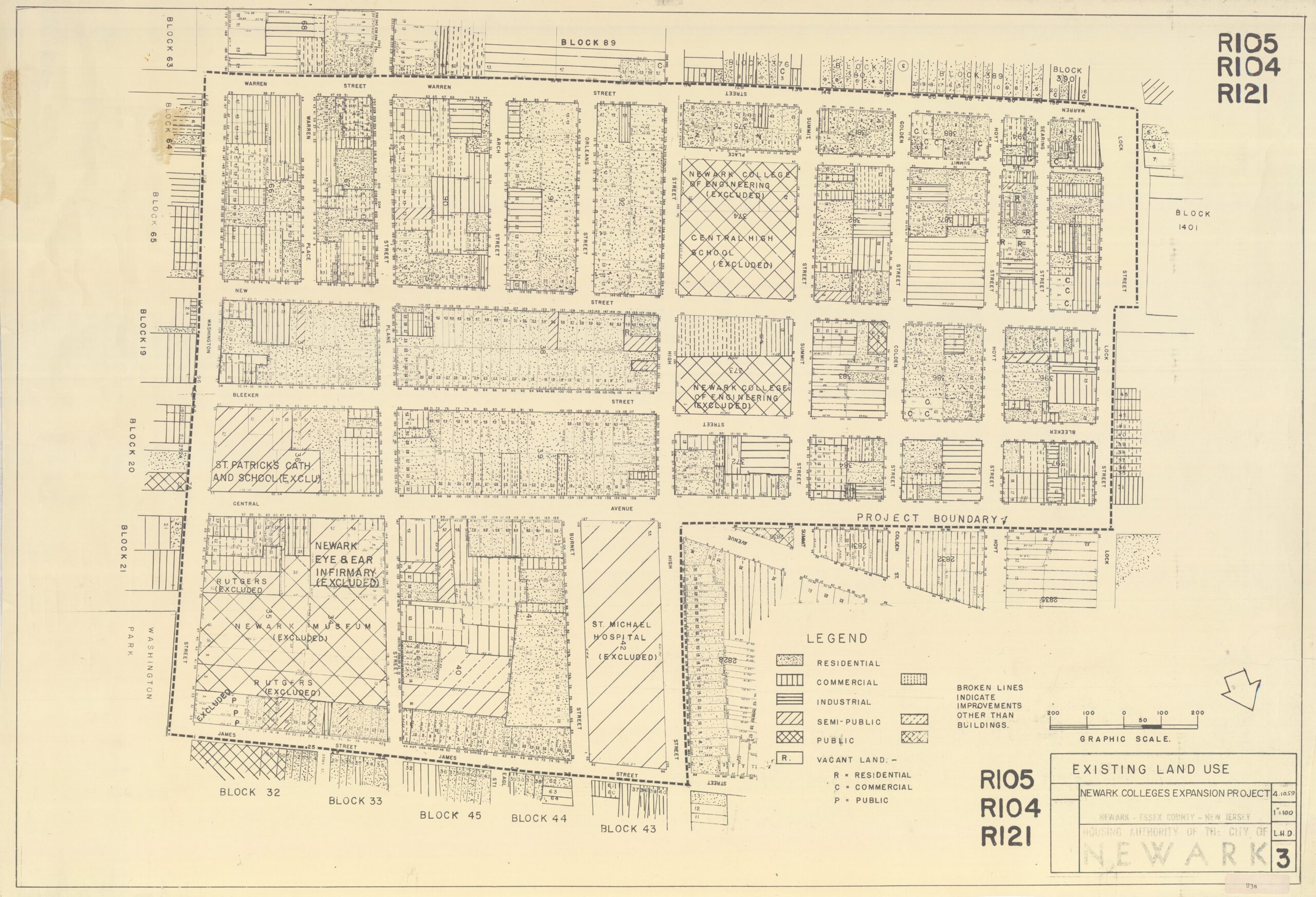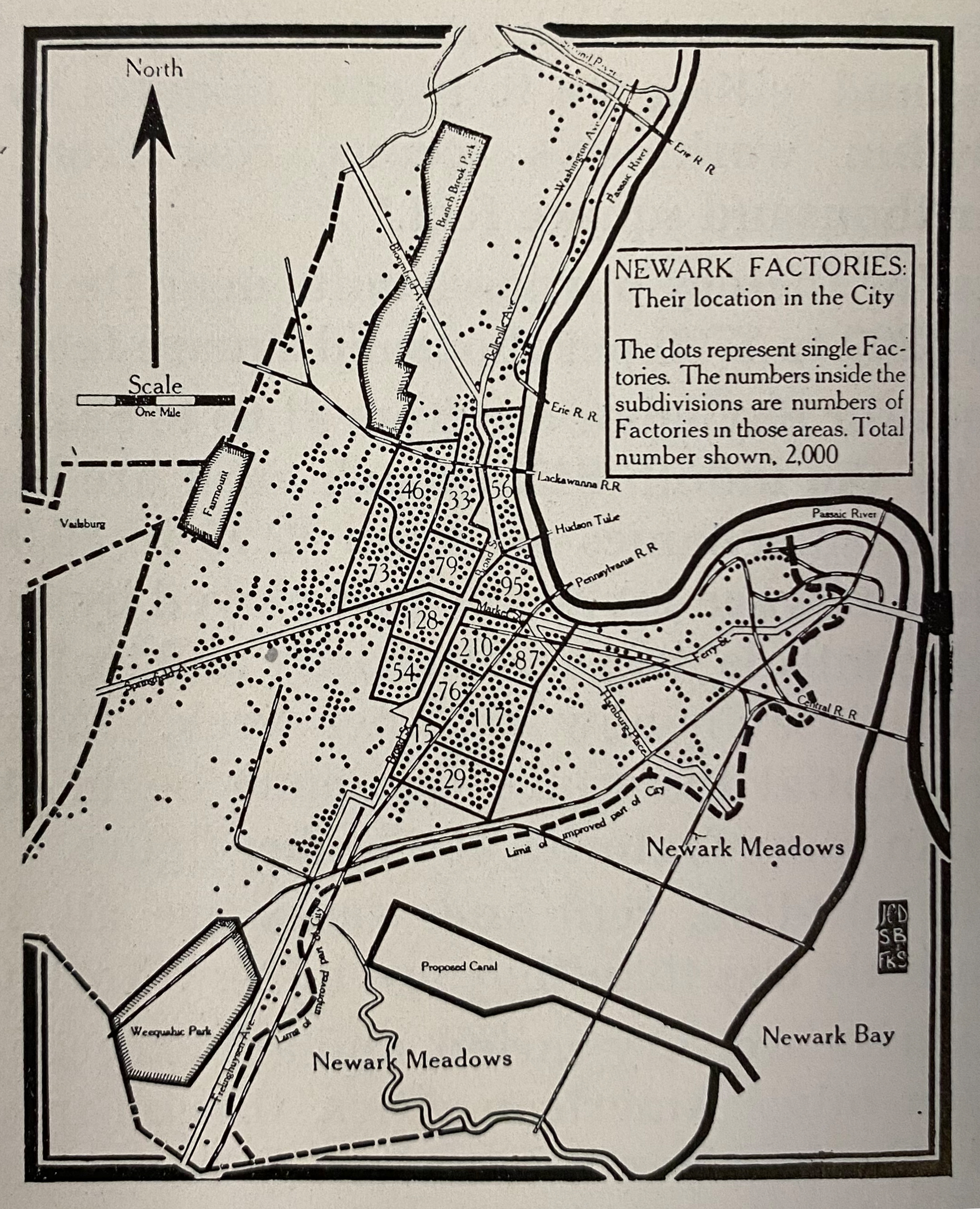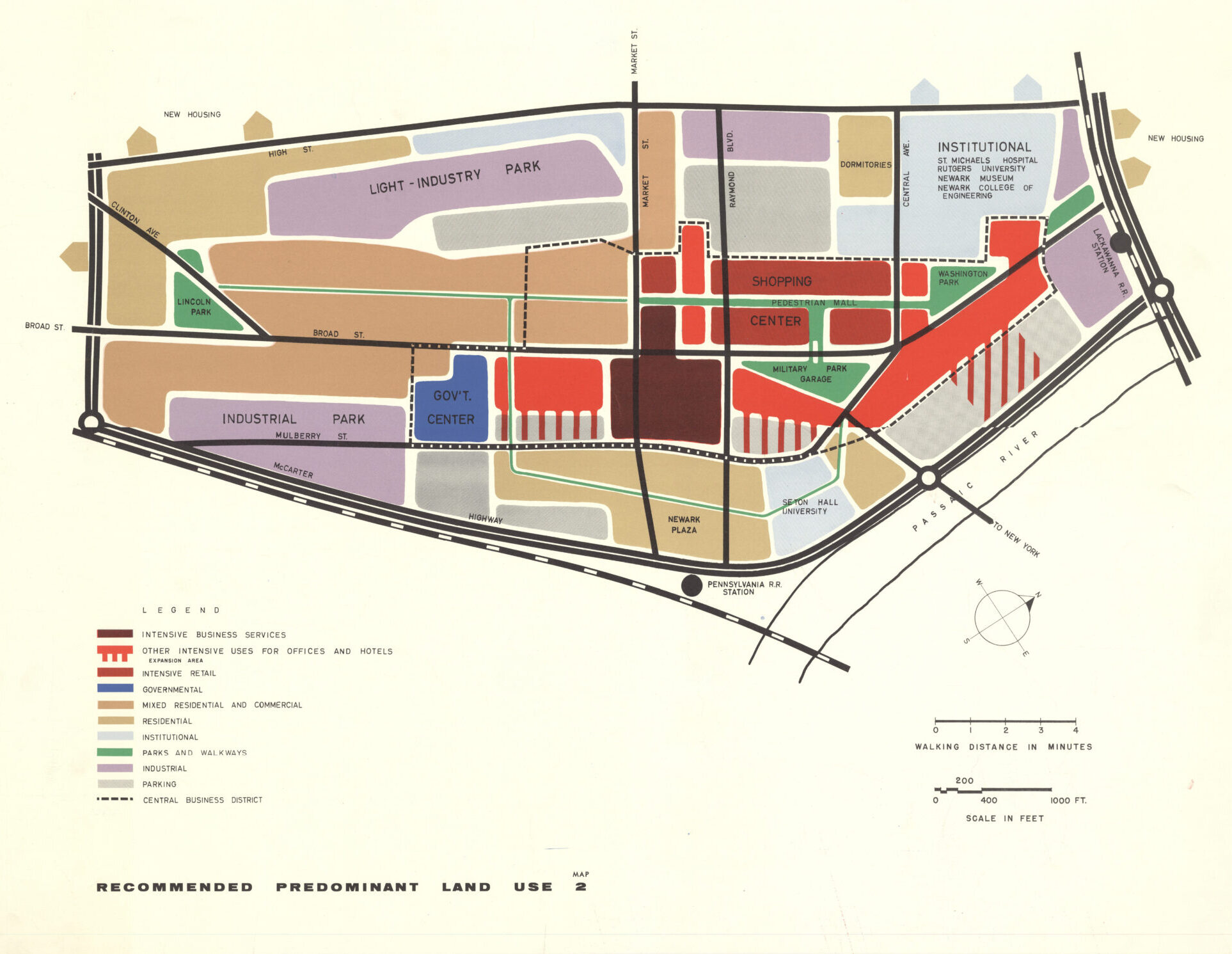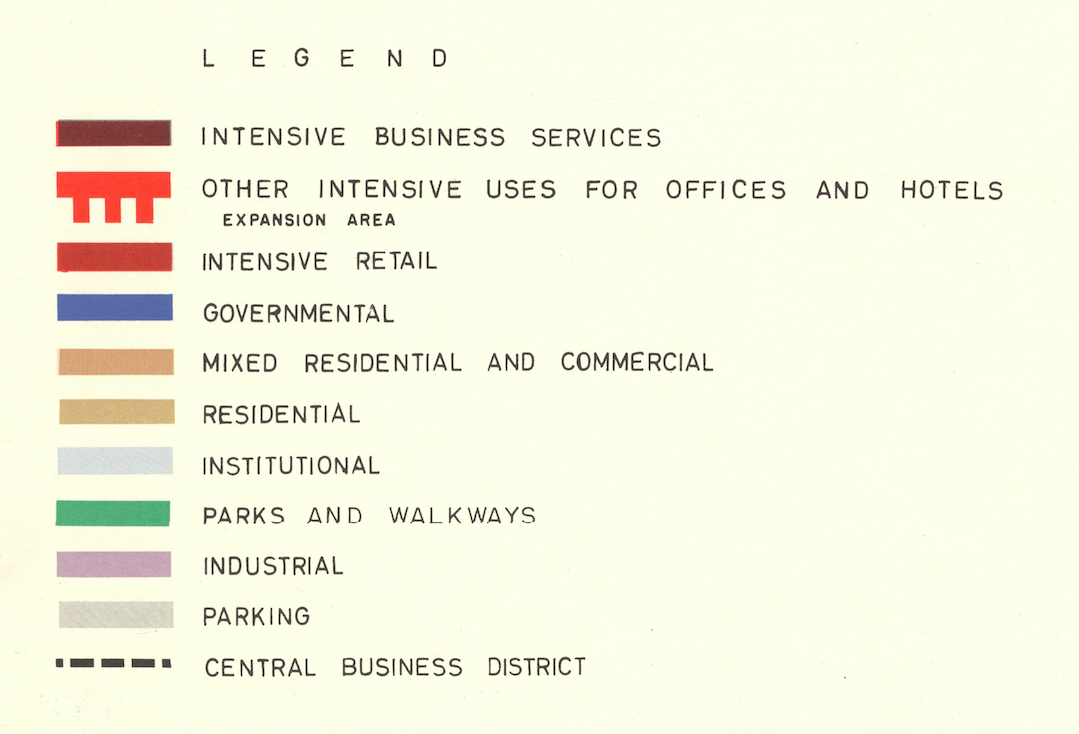
If you see this after your page is loaded completely, leafletJS files are missing.







Map of the neighborhood cleared to build the campuses of Rutgers (left) and the New Jersey Institute of Technology (right). As the first step in preparation for urban renewal, this survey map was created in 1959 of all property owners, property values, and property lines. Based on this map, the extent of the urban renewal area was determined and communicated to demolition crews.

From Harland Bartholomew’s 1913 master plan. So thorough was de-industrialization in Newark that not one factory dot from this image survives a century later, source.
This is New Jersey’s greatest concentration of polish and finance. It’s worn and blighted. But we have the spirit and vigor to grow and build anew as here in the new campuses of Rutgers University and the Newark College of Engineering. In time they will accommodate 25,000 students making Newark a college town. Newark has undertaken more urban renewal per capita than any other of the nation’s 30 major cities. In our time, one-fifth of our city will have been rebuilt with projects like these.
– 1966 newsreel on urban renewal efforts
During the past century, Newark lost the economic foundation it once had of factories, heavy industries, and easy-to-find employment on the factory floor. Detroit’s economy was shaped by the three largest employers – General Motors, Chrysler, and Ford – along with hundreds of other smaller industries that supplied parts and materials to the auto assembly lines. Newark’s industrial base, in contrast to an auto city like Detroit, a camera city like Rochester, and a fabric city like Lowell, was always more varied and more diverse in its number and variety of small manufacturers. However, no diversity of manufacturing enterprises excused any northeastern city from the aftershocks of industrial decline.
Economic growth follows a similar pattern on the local, national, and international scales. Manufacturing mostly happens in developing countries, where labor is cheap and raw materials are abundant. Meanwhile, more developed countries engage in new industries in the service sector, such as insurance, banking, and white-collar work in corporate America. This shift from industrial to service sector effected Newark and just about every American city of any size. There are winners like San Francisco now home to high-tech industries. And there are losers like Detroit that has not found (and will likely never find) a new industry that will give the city as much prosperity and wealth as the auto industry. Manufacturing jobs were the lever of social mobility for the working classes to migrate up into the middle classes. America’s shrinking manufacturing jobs mirror a shrinking middle class.
After WWII, there was a brief moment when it seemed Newark’s manufacturing base would survive. It was a moment when it seemed distant suburbs could grow and surround Newark without siphoning off people, energy, and employment from Newark. And yet, by the late 1950s, city leaders saw the city losing both people and its industrial base. Decades of technological progress had made factories larger, transportation cheaper, and mechanization easier. Factories needed fewer laborers to make more products, and hence there was less reason for factories to remain in cities like Newark. Taxes were higher, transportation was more expensive, and there was no need to remain within walking distance of the neighborhoods and immigrant enclaves where cheap immigrant laborers once lived.
In the 1910s, over 50% of Newark’s jobs were found in manufacturing and industries that served manufacturing. By 1912, there were 2,000 factories employing 76,000, producing goods worth $220 million. By the 1960s, this had fallen to less than 30%. And today, it is less than 5%. In the 1950s, Newark’s city leaders were worried with the trends they saw: declining industrial employment, rising unemployment, aging infrastructure and city services, declining tax revenue, and a population flight of wealth and middle-class people to the suburbs. Those left behind in Newark were the unemployed, the urban poor, Blacks, and a small but soon-to-grow number of immigrants from the Caribbean and Latin America. (Latin Americans and Mexicans only started arriving in northeastern cities after 1965 changes to immigration law.) Newark needed industrial employment, but it did not have the land in the centuries-old urban core for growing factories. Newark needed to attract and grow service sector jobs in insurance, banking, and higher education, but it did not have the financial resources to retain these employers downtown.
The truly dynamic American cities are those that are coming to grips with the problem of outmoded structures. Increasingly we are seeing large-scale demolition as the first step in building modern cities. the need of the hour is to acquire plottage by merging narrow lots for a new start. Getting needed space in our cities for modern structures is the only way to meet the competitive force of growing suburban strength.
– 1950s film from the U.S. Chamber of Commerce
In response, not just in Newark but nationwide, a program of urban renewal was introduced. University structures in Brutalist concrete replaced the homes of thousands of people. Newark’s new employment base would become the university. Industrial production would become knowledge production. In some ways, this dream became a reality. Newark is now the state’s largest college town with the campuses of Rutgers, Rutgers Medical School, Seton Hall, Essex County College, and the New Jersey Institute of Technology. Together these universities host 25,000 mostly middle-class students on land where 25,000 mostly-Black and working-class residents once lived. A more desirable social class has replaced a less desirable one. In other ways, the vision of urban renewal failed. Plans for the college campus replaced walkable, historical, and visually exciting streetscapes with hundreds of acres of surface parking and college campuses that face away from the street and city. All of Newark’s universities are commuter schools, where the majority of students and faculty live outside Newark. Newark has 200,000 jobs. Nearly half these jobs offer middle-class salaries upwards of $50,000. And yet, the majority of people who work in these schools live outside Newark. Wealth generated in Newark does not stay in Newark.
Dr. Berg’s photos show what the campuses of Newark’s universities looked like before clearance for urban renewal. These were mostly Black and multiracially integrated neighborhoods wiped clean from the map. City leaders reasoned that public housing, residential areas, and homes should not be near downtown. Mid-century planners used land use zoning to separate commercial and residential areas, to produce the mono-culture neighborhoods we see today that are all residential (and inactive on workdays) or all commercial (and inactive outside working hours). The White Downtown should be a commercial and commuter area. Downtown should be linked to the all-White suburbs by highways, and it should be separated from the nearby “Negro” neighborhoods by a belt of public housing and university campuses. Indeed, Downtown Newark is now surrounded to its west by the campuses of Rutgers and the New Jersey Institute of Technology. Blight and Black were to be buffered from the wealth of Downtown by the university. Educational institutions were transformed into tools of slum clearance and the city’s economic re-orientation.


Notice the brown arrows around perimeter of map pointing toward areas for constructing “new housing.” This table of urban renewal projects indicates that areas where housing was demolished and not replaced were concentrated in downtown. Areas where more housing was added than demolished were located closer to the city edge. This illustrates the drive toward population decentralization. (Source)
As you view these photos, consider: What can the university do to repair the damage it did in the 1960s to thousands of Blacks in dozens of neighborhoods? How can the redesign of its campuses better integrate into the urban streetscape and begin to rebuild the quality of urban form that was lost to urban renewal? If the built environment is to be a tool for social equity, then the university must be the place to start. Efforts over the past decade from Rutgers at its Living Learning Center and NJIT at its new dorms on Warren Street continue to transform these schools into anchor institutions and 24/7 campuses active in the city and in neighborhood life. Rutgers has come a long way in its urban polices, in its diversity of faculty and students, in its campus design, and in its urban focus since its 1960s origins as an agent of slum clearance.
.
Urban renewal “legislation defeated even the best intentions of public-spirited officials who took the mandate to clear slums seriously. In Newark, the local housing authority tried to replace crumbling tenements with decent housing. Clearance in poor black areas, however, merely left the Newark Housing Authority (NHA) in possession of considerable vacant land – private developers were not eager to invest in such areas. To make renewal work, the NHA discovered it had to jettison its original goals and become more “flexible” in dealing with private business. Rather than “peddling vacant land,” the NHA decided, in the words of one official, to “let the redevelopers tell us where they want to build.” “Choice sites” and standard structures subsequently fell before the wrecker’s ball, luxury apartments went up near the central business district, and much of the unmarketable vacant land in black areas was, for lack of suitable alternatives, devoted to public housing. As in Chicago, the ghetto was reinforced by new government-sponsored projects with indeterminate life-spans. Subsidies and profits flowed, as the business creed ordained, to the developers.
Arnold Hirsch. “Epilogue.” In Making the Second Ghetto: Race & Housing in Chicago 1940-1960. University of Chicago Press, 1983. Pp. 274-75.
The highway and automobile were two of the largest factors driving Newark’s 20th century decline in economic and political power.
For most of Newark history, the majority of population growth and economic energy were confined within the city limits. In 1910, Newark’s population of 347,000 was concentrated in Downtown and immediately adjacent neighborhoods. Within two miles of Downtown, large parts of the city remained farmland beyond the reach of commuter trolleys, pedestrians, and horse carriages. What is now Port Newark and Newark Airport were only salt marshes. Almost none of the South Ward and little of the North Ward were developed. The West Ward was a suburb most easily accessible to downtown by trolley.
Over a century, Newark – as well as just about every American town and city – witnessed massive population loss. At the same time, the city edge was developed from farmland into endless rows of suburbs. The automobile and highway made this transition from a high-density into a low-density city not only possible, but inevitable. No part of Newark is now untouched by urban sprawl. Newark’s population of 281,000 in 2020 represents fewer people spread out over a larger surface area than in 1910.
The Interstate Highway Act of 1956 offered funding to state and city governments for highway construction. This law changed the face of American cities. Federal funding covered up to 90% of land clearance and construction costs. In the web of highways that resulted, two major interstates sliced through Newark: Route 280 was carved through the Central and North Wards c.1960 while Route 78 was carved south through the Weequahic neighborhood c.1963. To clear the land for the path of both highways, at least 5,000 Newark residents were displaced, hundreds of small businesses were closed, and hundreds more homes were demolished.
For centuries, Blacks were locked out of owning their own land and homes. For the first time, migration to northern cities like Newark opened up the chance for them to own their own homes. While redlining practices from banks denied mortgages to many of them, growing numbers slipped through and bought their own homes. And yet, urban renewal and highway construction were erasing much of the progress these Black communities were making toward equal rights. For every one new Black resident to settle in Newark, two White residents left the city. Newark was losing population, at first slowly in the 1950s and then at an unstoppable pace by the 1970s.
Newly opened interstate highways displaced Black and non-White peoples from destroyed urban communities, while empowering White residents to flee the city for the suburbs. For the first time in Newark history, highways ensured that areas twenty or thirty miles distant from the city remained within commuting distance of White-collar jobs downtown. The result of highway construction was both population loss in the city center and a growing physical divide between Black and White communities. While the average Newark Black resident in 1960 was less than a mile distant from the nearest White neighborhood, by the 2000s Newark’s Blacks were separated from Whites by several miles. New Jersey remains racially and spatially divided. While highways were not the only factor responsible, their construction through Newark accelerated the already-present racial divisions.
With limited funding and competing special interests, the City of Newark had to choose between building more highways or building more affordable housing. The choice was made to build more highways instead of, and at the cost of, building more housing. City leaders and corporate interests argued that highways would clear away slums, would allow suburban residents to bypass slum areas, and then find easy parking downtown. It was more important to build highways and parking lots than housing and neighborhoods in downtown Newark. As Harold Kaplan described in his 1963 book Urban Renewal Politics:
In recent years, they had come to the conclusion that Newark’s future economic health depended upon a revitalization of its central business district. While sites should be cleared for new firms, the immediate emphasis should be on increased access for suburban shoppers to and from the business district. What Newark needed was a network of elevated highways emanating in radial spokes from the business district to carry the suburbanites quickly and safely over the slums. The City should clear sites for downtown parking lots, not for more tax-exempt public housing projects that use up good commercial real estate and seal off the central business district.
Samuel Berg documented almost every single building demolished for the path of Interstate 78 and 280. His photos show entire neighborhoods in the years 1959 to 1961, just months before they were declared “blighted” and cleared of all residents. And yet, his photos encourage us to be critical of when developers and governments call a neighborhood “blighted” and a “slum.” Not one abandoned building appears in his hundreds of photos of these neighborhoods. At the same time, the pedestrians and residents who appear in Berg’s photos are almost all Black. It was not the condition of these homes and the quality of their construction that led the state to call these areas “blighted.” It was the color of their skin coupled with the convenience of building a highway through neighborhoods where residents were too powerless and too poor to resist.
Highways destroyed more than homes along their paths. They also lowered the quality of life in nearby neighborhoods. Weequahic is now cut off from the rest of the city by Interstate 78’s fourteen lanes of asphalt. Newark residents suffer from elevated levels of asthma and air pollution from vehicles, elevated temperatures from higher amounts of paved surfaces, and elevated noise pollution from congestion.
The built environment must be a tool for social equity. Any program of reparations must consider how to erase the decades of damage – environmental, economic, and social – that these highways have caused to generations of Newark residents.